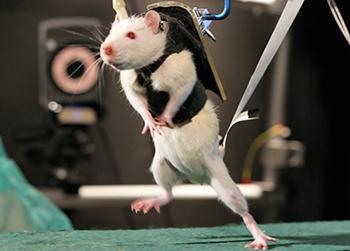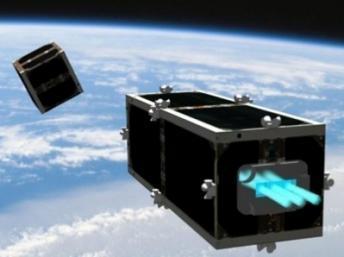Scientific advances that made 2012

© 2013 EPFL
2012 was an excellent year for research at EPFL. As a preview to a special section in the next Flash, here is a small selection of the most spoken-about scientific results from last year.
New forms of energy, advances in biotechnology, leaps and bounds in environmental research... EPFL's laboratories had quite the year. The January edition of the Flash will give you an overview of scientific research in 2012, as well as some of the events that made the year an excellent one for EPFL. While waiting for it to come out, here is a selection to whet your appetite.
Autoimmune diseases: retraining white blood cells White blood cells attack the pancreas of patients with type 1 diabetes. In a study published in PNAS, researchers have been able to completely eradicate this symptom in rodent models by “re-educating” the rebellious cells. And this concept could also be used to treat multiple sclerosis. Human trials are planned for 2014.
White blood cells attack the pancreas of patients with type 1 diabetes. In a study published in PNAS, researchers have been able to completely eradicate this symptom in rodent models by “re-educating” the rebellious cells. And this concept could also be used to treat multiple sclerosis. Human trials are planned for 2014.
-
Storing solar energy with water... and rust!
 Kevin Sivula's team has developed a photoelectrochemical tandem solar cell that is able to produce hydrogen from water and metal oxides. The original idea comes from another EPFL researcher, Michael Grätzel—but the prototype is the first of its kind to be made out of reasonably inexpensive materials and accessible technology. Published in Nature Photonics, the results could open the way to an economically-feasible way to store solar energy.
Kevin Sivula's team has developed a photoelectrochemical tandem solar cell that is able to produce hydrogen from water and metal oxides. The original idea comes from another EPFL researcher, Michael Grätzel—but the prototype is the first of its kind to be made out of reasonably inexpensive materials and accessible technology. Published in Nature Photonics, the results could open the way to an economically-feasible way to store solar energy.
EPFL and Harvard join forces to diagnose hearing loss
 What actually causes hearing loss in humans? And what are the best therapeutic approaches to this problem? These questions are constantly nipping at the heels of doctors. One reason is because current methods of observing cells in the inner ear cannot be done without irreparable damage to the cells. Researchers at EPFL and Harvard Medical School are working on a non-invasive laser technology that would allow for in-vivo, high-resolution images of these cochlear cells for the first time.
What actually causes hearing loss in humans? And what are the best therapeutic approaches to this problem? These questions are constantly nipping at the heels of doctors. One reason is because current methods of observing cells in the inner ear cannot be done without irreparable damage to the cells. Researchers at EPFL and Harvard Medical School are working on a non-invasive laser technology that would allow for in-vivo, high-resolution images of these cochlear cells for the first time.
Bacteria: a potential threat to nuclear waste repositories
 Some nuclear waste has to be safely stocked for thousands of years. Over time, microscopic chemical factories, better known as bacteria, change the storage environment little by little. Researchers have developed a method that combines genetics, computer science and geography to better understand the possible effects of the proliferation of these microorganisms in subterranean environments.
Some nuclear waste has to be safely stocked for thousands of years. Over time, microscopic chemical factories, better known as bacteria, change the storage environment little by little. Researchers have developed a method that combines genetics, computer science and geography to better understand the possible effects of the proliferation of these microorganisms in subterranean environments.
Rooting out rumors, epidemics, and crime – with math
 What do rumors on Facebook, viral epidemics and information on cellular telephone networks have in common? Their propagation follows shared rules. Pedro Pinto, researcher in computer science, has written an algorithm that is able to get to the source of the information. He was able to prove, after the fact, the origin of a cholera epidemic in Africa and even the originators of the attack on the Twin-Towers on September 11th.
What do rumors on Facebook, viral epidemics and information on cellular telephone networks have in common? Their propagation follows shared rules. Pedro Pinto, researcher in computer science, has written an algorithm that is able to get to the source of the information. He was able to prove, after the fact, the origin of a cholera epidemic in Africa and even the originators of the attack on the Twin-Towers on September 11th.
Walking again after spinal cord injury
 Thanks to electrical-chemical stimulations and the help of a robot, paralyzed rats have been trained to walk again—and the movement is completely voluntary. Even more surprising is the report that nerve connections grew not only at the medullary lesion but also in the brain itself. The research, published in Science, was picked up by the media around the world.
Thanks to electrical-chemical stimulations and the help of a robot, paralyzed rats have been trained to walk again—and the movement is completely voluntary. Even more surprising is the report that nerve connections grew not only at the medullary lesion but also in the brain itself. The research, published in Science, was picked up by the media around the world.
-
A janitor satellite to clean up space debris
 Thousands of rocket and satellite fragments circle the Earth at a speed of 30,000 km/h, and this proliferation of space debris is a growing risk for space exploration and industry. No surprise then that the idea of CleanSpace One was so seductive—it was mentioned throughout the world media and even made it on the front page of the New York Times!
Thousands of rocket and satellite fragments circle the Earth at a speed of 30,000 km/h, and this proliferation of space debris is a growing risk for space exploration and industry. No surprise then that the idea of CleanSpace One was so seductive—it was mentioned throughout the world media and even made it on the front page of the New York Times!